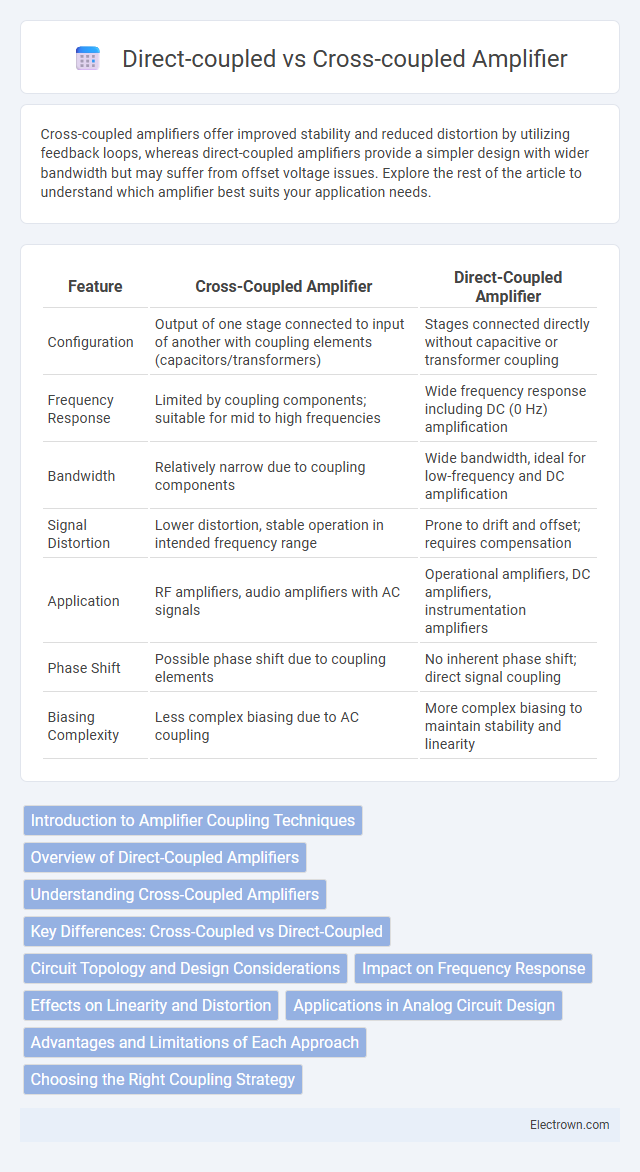Cross-coupled amplifiers offer improved stability and reduced distortion by utilizing feedback loops, whereas direct-coupled amplifiers provide a simpler design with wider bandwidth but may suffer from offset voltage issues. Explore the rest of the article to understand which amplifier best suits your application needs.
Table of Comparison
| Feature | Cross-Coupled Amplifier | Direct-Coupled Amplifier |
|---|---|---|
| Configuration | Output of one stage connected to input of another with coupling elements (capacitors/transformers) | Stages connected directly without capacitive or transformer coupling |
| Frequency Response | Limited by coupling components; suitable for mid to high frequencies | Wide frequency response including DC (0 Hz) amplification |
| Bandwidth | Relatively narrow due to coupling components | Wide bandwidth, ideal for low-frequency and DC amplification |
| Signal Distortion | Lower distortion, stable operation in intended frequency range | Prone to drift and offset; requires compensation |
| Application | RF amplifiers, audio amplifiers with AC signals | Operational amplifiers, DC amplifiers, instrumentation amplifiers |
| Phase Shift | Possible phase shift due to coupling elements | No inherent phase shift; direct signal coupling |
| Biasing Complexity | Less complex biasing due to AC coupling | More complex biasing to maintain stability and linearity |
Introduction to Amplifier Coupling Techniques
Cross-coupled amplifiers utilize feedback through cross-connected transistors to enhance stability and gain, making them suitable for oscillator circuits and RF applications. Direct-coupled amplifiers provide a continuous DC connection between stages, enabling amplification of low-frequency signals without capacitor coupling, ideal for DC and low-frequency analog signal processing. Your choice between these coupling methods depends on the desired frequency response, signal integrity, and application requirements.
Overview of Direct-Coupled Amplifiers
Direct-coupled amplifiers use a continuous electrical connection between stages, allowing them to amplify signals down to zero frequency, including DC components. This design eliminates coupling capacitors or transformers, resulting in a wider bandwidth and improved low-frequency response compared to cross-coupled amplifiers. Your applications benefit from stable operation at all frequencies, making direct-coupled amplifiers ideal for DC amplification and low-frequency signal processing.
Understanding Cross-Coupled Amplifiers
Cross-coupled amplifiers utilize feedback between transistors to enhance gain, stability, and linearity, making them ideal for RF and high-frequency applications. Unlike direct-coupled amplifiers, cross-coupled designs reduce distortion by canceling non-linear components through their symmetrical configuration. Understanding these key differences enables you to optimize amplifier performance for specific circuit requirements and signal integrity.
Key Differences: Cross-Coupled vs Direct-Coupled
Cross-coupled amplifiers use a feedback loop with transistors connected in a manner that enhances stability and noise rejection, making them ideal for oscillator and mixing applications. Direct-coupled amplifiers connect transistor stages directly without capacitive or transformer coupling, allowing for wide bandwidth and DC signal amplification but often suffering from drift and offset issues. The primary difference lies in signal coupling method and application focus: cross-coupled designs prioritize phase stability and feedback control, while direct-coupled designs emphasize continuous signal amplification over a broad frequency range.
Circuit Topology and Design Considerations
Cross-coupled amplifiers utilize feedback loops between transistors to enhance gain and stability, creating a balanced circuit topology ideal for differential signal amplification. Direct-coupled amplifiers feature a straightforward cascade of stages without capacitive coupling, enabling DC signal amplification but requiring careful biasing to avoid distortion and thermal instability. Your choice between these topologies depends on desired frequency response, linearity, and power efficiency in the specific application.
Impact on Frequency Response
Cross-coupled amplifiers exhibit improved stability and enhanced high-frequency response due to reduced parasitic capacitance and feedback effects, making them suitable for RF applications. Direct-coupled amplifiers often experience limited bandwidth and degraded frequency response because of increased low-frequency drift and thermal instability caused by continuous current flow through transistor junctions. The choice between cross-coupled and direct-coupled configurations significantly impacts the gain-bandwidth product and overall signal integrity in frequency-sensitive circuit designs.
Effects on Linearity and Distortion
Cross-coupled amplifiers typically exhibit improved linearity due to their negative feedback mechanism, which reduces distortion by stabilizing gain and minimizing nonlinear behavior. Direct-coupled amplifiers, while simpler and capable of DC amplification, often suffer from higher distortion levels caused by inherent transistor nonlinearities and thermal variations. Your choice between these amplifier types impacts signal fidelity, with cross-coupled designs preferable for applications demanding lower distortion and higher linearity.
Applications in Analog Circuit Design
Cross-coupled amplifiers are widely used in analog circuit design for oscillators and mixers due to their ability to provide positive feedback, enhancing signal gain and stability. Direct-coupled amplifiers are preferred in low-frequency and DC amplification applications because they avoid coupling capacitors, enabling accurate signal transmission with minimal distortion. Your choice between these amplifier types depends on the specific frequency response and signal integrity requirements of your analog circuit design.
Advantages and Limitations of Each Approach
Cross-coupled amplifiers offer enhanced gain and improved linearity by utilizing feedback between stages, which reduces distortion and increases efficiency, but they can introduce complexity in design and stability challenges. Direct-coupled amplifiers provide a wide bandwidth and low-frequency response without coupling capacitors, making them ideal for DC amplification and low-frequency signals, though they may suffer from offset voltage drift and limited gain due to transistor mismatches. Selecting between cross-coupled and direct-coupled amplifiers depends on the specific application requirements for gain, frequency response, and stability.
Choosing the Right Coupling Strategy
Choosing the right coupling strategy depends on the desired trade-offs between bandwidth, stability, and signal distortion. Cross-coupled amplifiers offer improved linearity and reduced even-order harmonic distortion, making them suitable for RF and high-frequency applications, whereas direct-coupled amplifiers provide a wider bandwidth and a simpler design ideal for DC amplification and low-frequency signals. Careful analysis of the application's frequency response and noise requirements ensures optimal amplifier performance and efficiency.
Cross-coupled vs direct-coupled amplifier Infographic

 electrown.com
electrown.com